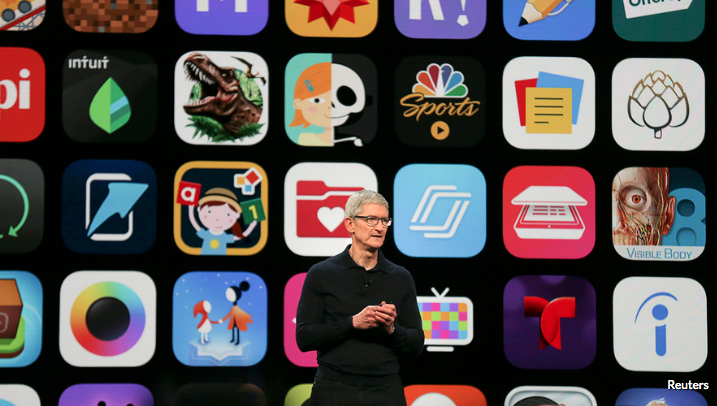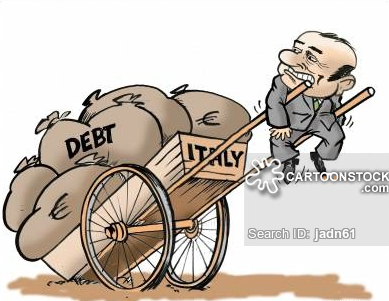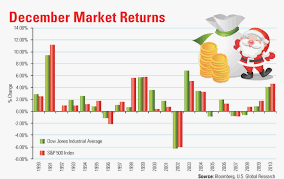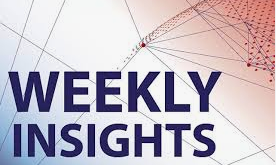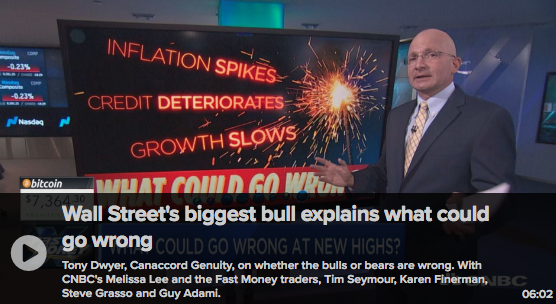The tech sector was hit, once again, quite hard in the early going hours of trading on Wednesday, but the sector rallied hard in the afternoon hours. In total, the trading days proved rather benign with the major averages finishing mixed. The S&P 500 index edged up 1.03 points to 2,888.92, less than 0.1%, and the Dow Jones Industrial Average rose 27.86 points, 0.1%, to 25,998.92. The S&P 500 hasn’t had a 1% move in 54 consecutive trading sessions. The VIX has been in a state of complacency (reading below 15) for several months now. The VIX would need to tick higher in order for greater S&P 500 moves, intraday, to be exacted. Meanwhile, the Nasdaq Composite Index finished lower by 18 points, or 0.2 percent. The early morning trade looked like traders were in retreat mode, with all 3 major averages lower until…trade talk came to the forefront once again.
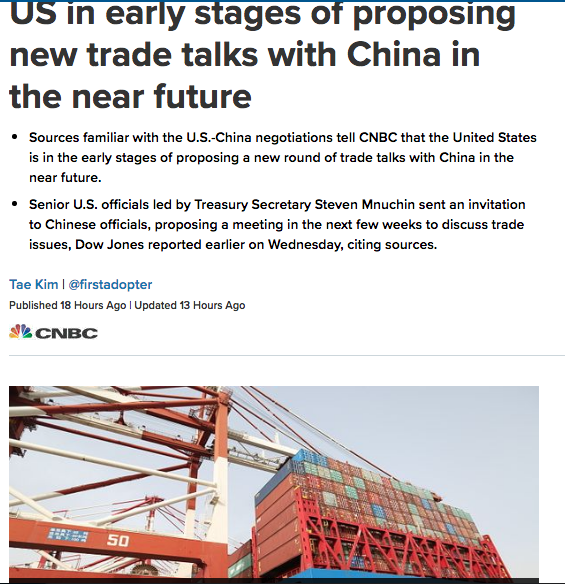
In the latter morning hours, headlines crossed stating that the Trump administration is giving Beijing another chance to try to stave off new tariffs on $200 billion in Chinese exports, asking top officials for a fresh round of trade talks later this month. The invitation from Treasury Secretary Steven Mnuchin comes as some Trump officials said they sense a new vulnerability, and possibly more flexibility, among Chinese officials pressured by U.S. tariffs imposed earlier this year and threats for more to come. Equities rose sharply on the news with the Dow taking the lead. The Dow rose by as much as 150 points on the news before greatly curtailing its gains later in the trading session.
Economic data was light for Wednesday, but somewhat reflective of the Fed’s inflation mandate and target for future rate hikes. In the latest economic data, the wholesale cost of U.S. goods and services fell in August for the first time in a year and a half, as the recent upturn in inflation appeared to ease. The producer price index declined by 0.1% last month, the Labor Department said Wednesday.
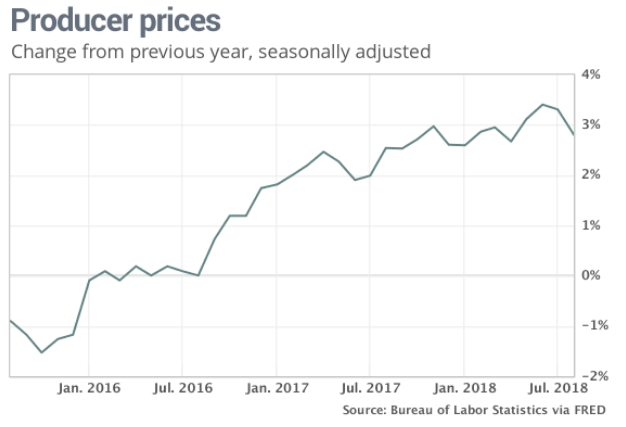
Economists polled by MarketWatch had forecast a 0.2% increase. The decline was tied to lower margins for services such as retail and transportation, a volatile category. The cost of services fell by 0.1% and accounted for the decline in overall wholesale inflation. The price of goods was unchanged. A 0.4% increase in the wholesale cost of gasoline and other forms of energy was offset by a 0.6% decline in food prices.
Also released Wednesday was the Fed’s Beige Book. The Beige Book spoke to the strength in the economy and prospects for future rate hikes. Three of the Fed’s 12 districts reported weaker growth in August, according to the Federal Reserve’s latest Beige Book report released Wednesday. While the overall U.S. economy expanded at a “moderate pace,” trade concerns and a lack of workers delayed projects. There were also “some signs of a deceleration” in prices of final goods and services.
In total, the Fed’s Beige Book painted a picture of an economy that is in no danger whatsoever of overheating. Top Fed officials, led by Fed Chairman Jerome Powell, remain committed to raising the benchmark short-term interest rate again at the next policy meeting on Sept. 25-26. Only a few voting members on the central bank committee have been urging their colleagues to hold off on further tightening.
The release of the Fed’s Beige Book comes prior to Thursday’s European Central Bank’s meeting. Before the ECB meeting, a report from Bloomberg News said staff will cut the eurozone’s growth outlook, citing officials familiar with the matter. Softer economic projections could also delay the timing for the central bank’s first rate increase since 2011.
After a strong Asian market session overnight, U.S. equity futures are pointing to a modestly higher open. The tech sector, having been beat up of late, looks to rebound after Apple’s unveiling of 3 new iPhones on Wednesday. Apple (AAPL) unveiled two new OLED models, dubbed the iPhone XS and the iPhone XS Max. The first is a slightly upgraded version of the current 5.8-inch iPhone X, while the XS Max is similar, except with a 6.5-inch screen size. The iPhone XS Max has a similarly sized body to the iPhone 8 Plus, but which much more usable screen space.
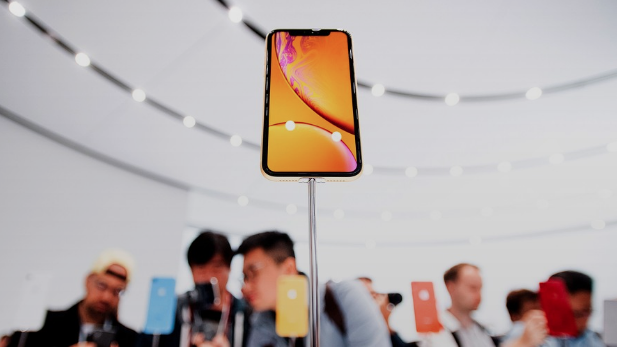
The third phone is the iPhone XR, an LCD model that has the same look as the other two. The phone will come in white, black, blue, coral, or yellow, and there’s also a Product Red option. The device starts at $749, which is cheaper than the iPhone 8 Plus. Preorders begin Oct. 19, and the phones start shipping a week later.
Piper Jaffray analyst Michael Olson penned an upbeat note on Apple late Wednesday, following the company’s iPhone launch event. Olson expects “improving upgrade rates” thanks to the company’s new iPhone lineup, which he thinks provides consumers more choice, as well as more reasons to upgrade to the new “X” form factor. He is optimistic about the company’s “wide range of pricing,” as the iPhone XR starts at $749 and the iPhone XS Max can cost as much as $1,449. Olson upped his expectations for Apple’s fiscal-year 2019 average selling prices to $758 from $735 previously. He projects an ASP of $739 for this fiscal year.
Apple also announced the Apple Watch Series 4, which features an edge-to-edge screen and comes in both 40-millimeter and 44-millimeter versions. Each watch features different ways to use “complications,” or mini applications, on the watch face. One watch face supports up to eight complications, and there are new ones, including an option to display small photos of your loved ones on the screen and tap their faces when you wish to contact them. The new watch has the same 18-hour battery life as its predecessor.
One of the more impressive features announced and displayed in the AWS4 was an electrocardiogram option, which will let users take ECGs on their wrists. The company has received clearance from the Food and Drug Administration for this feature. The non-cellular version will start at $399 while the cellular option begins at $499.
The chip sector and Apple led the tech sector lower in Wednesday’s trade. The tech-heavy Nasdaq was off by more than 80 points intraday yesterday and before finishing slightly lower on the day. The Nasdaq is leading equity markets once again in 2018, up more than 15% year-to-date. Having said that, the index has struggled in September, thus far. Where the Nasdaq heads next could be the key to the balance of the year for investors. Andrew Adams, senior research associate at Raymond James, dubbed the following chart as “the most important chart in the world.” It’s a look at the Nasdaq over the past 10 years.
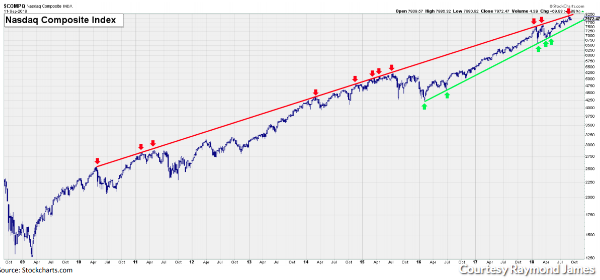
“This line has stopped the Nasdaq in its tracks several times over the last few years, and the broad market typically doesn’t make it very far without the tech-heavy Nasdaq leading the way,” Adams wrote. “The overhead resistance is also why it may be tough to see significant upside in the near term without the index breaking out above the line.”
“The Nasdaq has tested both ends of this trading range in 2018, and “until we get a break in either direction, we must assume these lines will continue to act as upper and lower boundaries for the Nasdaq.”
Heading into the latter portion of the trading week, investors will be confronted with more inflationary economic data via the Consumer Price Index on Thursday. Core CPI is expected to tick higher by .2% according to economists polled by MarketWatch. On Friday, the consumer will come into focus once again. At 8:30 a.m. EST, the Census Bureau will release monthly retail sales. The expectation is for retail sales to have risen by .3% in August according to economists polled by MarketWatch. Consumer sentiment is set to be released at 10:00 a.m. EST. Economists expect the reading to tick up to 97% from a previous reading of 96.2 percent in August.
Tags: AAPL DJIA NDX QQQ SPX SPY UVXY VIX XLK
